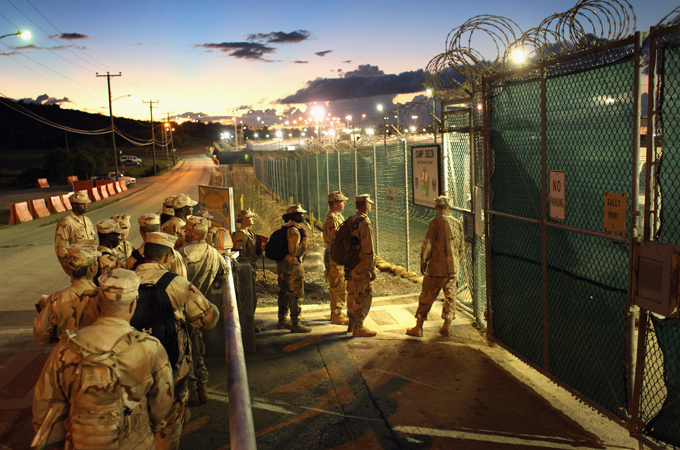Guantanamo turns ten
Jonathan Hafetz discusses the three stages of Guantanamo’s life as the ‘flagship prison’ in the ‘war on terror’.

 |
| All three branches of the US government are equally responsible in not shutting down Guantanamo Bay [GALLO/GETTY] |
New York, NY – Today marks ten years from the date the United States brought the first prisoners to its naval base at Guantanamo Bay, Cuba. Since then, Guantanamo has provided a mirror of sorts, reflecting the aspirations, limitations, and contradictions of America’s global “war on terror”. A decade at Guantanamo highlights the extent to which the United States remains imprisoned by its past mistakes. While its approach to terrorism has evolved, the United States’ failure to close Guantanamo shows how far it still has to go if it wishes to develop a rights-respecting national security policy.
Guantanamo’s life as the flagship prison in the war on terror may be divided into three stages. While these stages overlap, they provide a useful way of examining how US policy has changed – and failed to change – over time.
The prison outside the law
Guantanamo’s early and defining years were marked by the Bush administration’s overriding goal of creating a prison beyond the law. Guantanamo seemed suited for this purpose: an enclave over which the United States exercised total jurisdiction and control but lacked formal sovereignty (Guantanamo still nominally belongs to Cuba under a 1903 treaty and subsequent lease agreements). Seizing on the legal fiction that Guantanamo was not part of the United States, the Bush administration argued that prisoners held there were necessarily outside the protection of the US Constitution and court system. Further, the Bush administration invented a label – “enemy combatant” – as a way of denying detainees any protections under the Geneva Conventions. The result, as noted British jurist Johan Steyn explained, was the establishment of a “legal black hole”.
| Inside Story Americas – Is Guantanamo still relevant? |
The consequences of this legal black hole are by now familiar. Prisoners were not only denied access to habeas corpus but were also subjected to brutal treatment, including painful stress positions, prolonged isolation, and extreme sensory deprivation. An International Committee of the Red Cross report, leaked to the press in 2005, described conditions at Guantanamo as “tantamount to torture”.
Guantanamo, however, was always more than a prison. It represented a new form of detention in which prisoners were held in secret and without legal protections to facilitate the use of harsh interrogation methods. The interrogation methods employed at Guantanamo soon migrated to Iraq, where they contributed to the Abu Ghraib prison scandal. The legal theories underlying Guantanamo also facilitated the creation of secret CIA prisons, or “black sites”, where “high-value detainees” were subjected to waterboarding and other forms of torture.
Litigation, public opposition, and pressure for closure
Shortly after the first prisoners were brought to Guantanamo, habeas corpus petitions were filed on their behalf. In 2004, the Supreme Court recognised the detainees’ right to seek judicial review of their detention under federal law and, soon afterwards, attorneys began visiting the base regularly. In subsequent decisions, the Court affirmed detainees’ right to habeas corpus in the face of sustained congressional efforts to repeal it. The Court also made clear that, even in an armed conflict with a terrorist organisation like al-Qaeda, all prisoners must receive the protections of Common Article 3 of the Geneva Conventions, which forbids torture and other mistreatment.
Meanwhile, domestic and international opposition to Guantanamo continued to grow, as people learned more about the prison and the treatment of detainees there. Along with court decisions, public opinion helped force the US government to accept some changes at Guantanamo, gradually leading to better conditions for prisoners and an end to the most abusive interrogation practices.
| IN Depth | |||||||||||
|
Strategic and human rights interests increasingly converged. In addition to threatening the rule of law, Guantanamo was seen as undermining US counter-terrorism efforts by tarnishing America’s credibility and reputation. This convergence reached an apex during 2008 presidential election, when candidates from both major parties said Guantanamo should be shut, and then following Obama’s inauguration, when the president ordered the prison’s closure within a year. Guantanamo, Obama explained in a May 2009 speech at the National Archives, was founded on “the misplaced notion” of creating a prison beyond the law and had become a symbol of injustice that “likely created more terrorists around the world than it ever detained”.
Difficult questions, to be sure, remained, including what would happen to the remaining detainees and whether the United States would do anything to ensure accountability for past abuses. But, with Obama’s election, at least Guantanamo’s days seemed numbered.
Retreat and institutionalisation: Guantanamo forever?
The United States’ failure to close Guantanamo is the result of several factors, including lack of leadership by the executive, opposition by Congress, and acquiescence by the courts. Ultimately, all three branches of government bear responsibility, along with the American people themselves, who continue to tolerate Guantanamo’s existence.Three years later, Obama’s plan to close Guantanamo is in shambles. Not only does the prison remain open, but the United States is further from closing it now than at any time in the past.
Congress bears primary responsibility. Lawmakers have taken a number of steps to make closing Guantanamo virtually impossible. They have barred the use of Defense Department funds to transfer Guantanamo detainees to the United States. These restrictions have not only prevented the Obama administration from resettling in the United States at least some of the approximately eighty detainees it has cleared for release. They have also prevented the administration from bringing detainees to the United States for any purpose, including for criminal prosecution in federal court or continued law-of-war detention, even in a maximum-security federal prison. Additionally, Congress has imposed onerous certification requirements on the executive before it can transfer Guantanamo detainees to another country.
Yet, Congress is not alone to blame. Since ordering Guantanamo’s closure, Obama has shown both a lack of leadership and an unwillingness to expend political capital to make closure a reality. During the critical first months after his inauguration, Obama failed to take steps to operationalise his promise. Instead, the president allowed a backlash to spread among Congress and the American public.
| Uighur Guantanamo inmates left in limbo |
One missed opportunity followed another. In early 2009, the administration had the chance to settle a handful of Uighur detainees in the United States. The government acknowledged that the Uighurs – who could not be returned to China for fear of persecution – presented no danger to the United States. Arrangements had been made to help integrate the detainees into a large Uighur community in Northern Virginia. However, as soon as the Obama administration sensed some opposition, it abandoned its plan to bring the Uighurs stateside. Soon thereafter, Congress enacted its first set of transfer restrictions. This effectively closed the door on detainee transfers to the United States and weakened the government’s ability to enlist the support of other countries for Guantanamo resettlements generally.
The administration also neglected to lay the necessary political groundwork to ensure the success of one of its most important initiatives: the transfer of alleged 9/11 mastermind Khalid Shaikh Mohammed and his co-conspirators to New York for prosecution in federal court. The administration failed to line up the necessary political support in New York beforehand and to defend the prosecution after it announced its decision. To those who supported keeping Guantanamo open, the administration’s subsequent reversal was a sign of weakness – an indication that Obama would not fight for closure.
Further, Obama accepted key policies underlying Guantanamo, including indefinite detention and prosecution in military commissions as alternatives to charging terrorism suspects in the regular court system. Instead of abandoning indefinite detention, the administration tried to bring detentions closer in line with international law; rather than scrapping the widely criticised system of military commissions, it helped push through new legislation improving some of the commissions’ flaws. While commissions remain a second-class justice system in many ways, the reforms have made them more sustainable and helped diffuse criticism of Guantanamo more generally.
Finally, while Guantanamo detainees nominally have access to the courts through habeas corpus, judges have become increasingly reluctant to grant them relief. After district judges finally started holding hearings in 2008, they granted an overwhelming majority of the Guantanamo detainee habeas petitions that they reviewed. However, the federal appeals court in Washington, DC, subsequently interpreted habeas corpus in highly restrictive terms. In the sixteen cases it has decided since 2009, the appeals court has not granted relief outright to a detainee in a single case, nor has it affirmed a district court decision ruling in a detainee’s favour. District judges have gotten the message. No detainee has prevailed in his habeas petition since July 2010. Moreover, even if by chance a detainee does prove there is no basis for his confinement, a judge has no authority to order his release under existing precedent. Dissenting from the appeals court’s most recent Guantanamo detainee decision, Judge David Tatel wrote that it is “hard to see what is left of the Supreme Court’s command” that habeas review be “meaningful”.
Meanwhile, public concern about Guantanamo continues to dissipate. The United States has gotten used to Guantanamo – indeed, even addicted to it. While conditions have improved, Guantanamo remains a place where individuals – all citizens of other countries – are given fewer rights and protections against unlawful imprisonment. Guantanamo will never gain international legitimacy. To the contrary, as long as it remains open, it will remain a symbol of the United States’ refusal to take seriously its commitment to human rights and equal treatment under law.
Jonathan Hafetz, a professor at Seton Hall Law School, is the author of Habeas Corpus after 9/11: Confronting America’s New Global Detention System.
The views expressed in this article are the author’s own and do not necessarily reflect Al Jazeera’s editorial policy.
